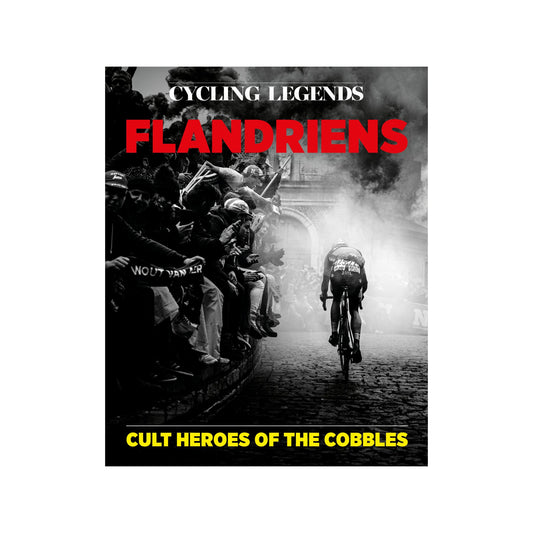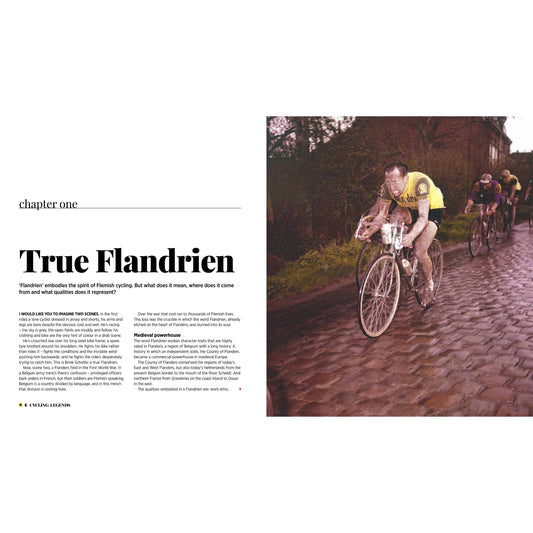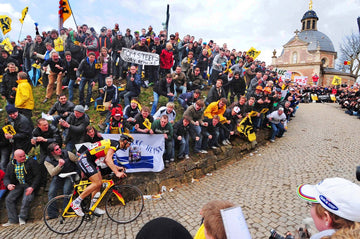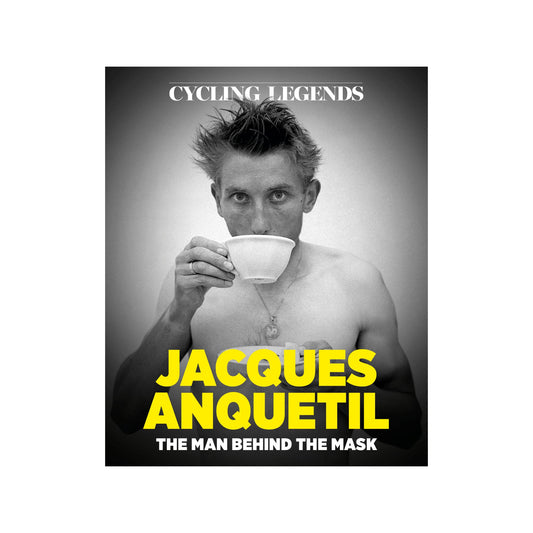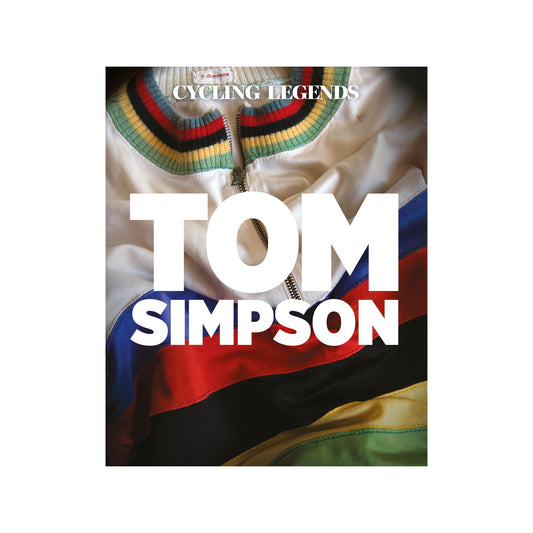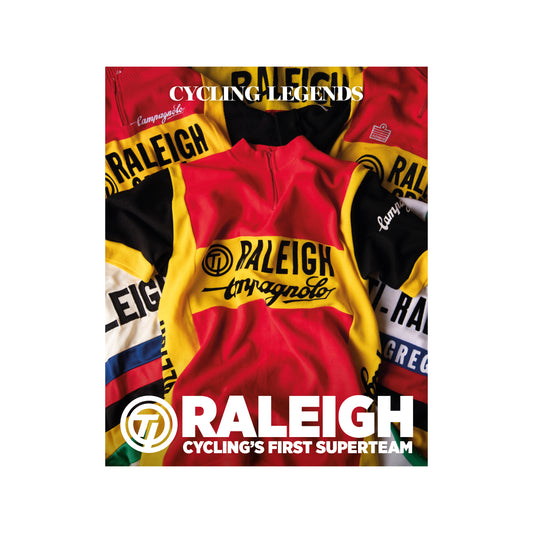Words - Chris Sidwells
Photos - Presse Sports, Photosport International and Cycling Legends 04: Flandriens - Cult Heroes of the Cobbles
Cycling’s Holy Week is the time of Ghent-Wevelgem, Tour of Flanders and Paris-Roubaix. Today we feature the two riders who won all three in the same year.
Both are Belgian, both true Flandriens and both the best single-day race riders of their generation. In fact they are two of the very best of all time - Rik Van Looy and Tom Boonen.
Van Looy was the first and the only one to win all three races in the same week. They are spread over a fortnight now so it should probably be called Holy Fortnight, but that doesn’t trip off the tongue anywhere near as well.
Both were brilliant, masterful, but Van Looy’s had an extra dimension that Boonen’s didn’t. Not only were the three races strung between two consecutive Sundays, he won them all wearing the rainbow jersey of world champion. And that is unique!

Rik Van Looy in the rainbow jersey
Revenge
Winning a monument in the rainbow jersey, like Lotte Kopecky and Tadej Pogačar did at the weekend, is special, so when a Belgian has a chance to win Flanders as world champion they do everything to take it. Except in 1961 Rik Van Looy couldn’t.
He was world champion, but crashed at a crucial point in the race, couldn’t continue and a 23 year-old British pro, Tom Simpson, won at his first attempt. Simpson was in the winning break the following year, and so was Van Looy.
Simpson attacked on a cobbled climb, but Van Looy dragged him back. It was a tough day out, but the Belgian was tougher, and there were fewer climbs that year than there are now.
Simpson ran out of terrain to hurt Van Looy, but still kept attacking on the flat run to finish. Unfortunately he only managed to lose one of the five Belgians with him, Jef Planckaert, and Van Looy attacked with three kilometres to go. The others hesitated, and he’d gone. Van Looy was first, 9 seconds in front of Belgian champion Michel Van Aerde and the rest, with Simpson fifth.

Rik Van Looy leading Tom Simpson during the Tour of Flanders
Wevelgem and Roubaix
Both races were straightforward for Van Looy. On the road to Wevelgem he moved clear in a four-man Belgian breakaway, just as he had in Flanders, but with no Simpson this time. Van Looy left the break towards the end, and Simpson led in the group after them for 6th.
There was an added British dimension to the day though. Simpson and the man who ran his supporters club, Albert Beurick of the Café den Engel in Ghent, were running a training camp based at the café for British amateurs. They took part in the amateur Ghent-Wevelgem as part of their package. It was one of the first such ventures for riders from the UK.
Roubaix went in similar vein, Van Looy was the best he’d ever been, ever would be that year. Another five-man break triumphed, this time four Belgians and a Frenchman, Raymond Poulidor.
Poulidor attacked 14 kilometres from the finish, but Van Looy quickly caught him and rode right by. Churning a massive, for those days, 54 x 14 gear all the way to Roubaix to win alone 25 seconds ahead of his former breakaway companions. A shattered Poulidor was fifth.

Rik Van Looy in full flight along the cobbles
Boonen’s holy fortnight
Fast forward 50 years, and several other cobbled classics superstars from Belgium, the latest, Tom Boonen was at the height of his powers. He dominated the cobbled classics, just like Van Looy had.
An E3 Prijs and Ghent-Wevelgem double, won just two days apart kicked off Boonen’s 2012 holy fortnight. He outsprinted two Italians, Filippo Pozatto and Alessandro Ballan, to win the Tour of Flanders. Then the following Sunday he broke clear of the leaders with team mate Niki Terpstra, but was in such form and so strong that Terpstra couldn’t hold him as he continued alone to Roubaix.
It was an incredible display and capped a glorious period for Boonen. He’d equalled Rik Van Looy’s feat of winning all three of the biggest cobbled classics in the same year. He was the fifth rider in history to win the Tour of Flanders three times and, biggest of all, he’d equalled the four Paris-Roubaix victories of Roger De Vlaeminck.

Nuts and bolts
How did he do it all? What were the nuts and bolts of Tom Boonen that made him so good? The man who knows best is Tom Steels, a former multi-Belgian champion and winner of Het Volk and Ghent-Wevelgem, who was the coach of Boonen’s team. “Tom was fast, very strong and could generate a tremendous amount of power, his power numbers were really incredible, but he was also very dedicated when he had an objective.

Tom Boonen riding the cobblestones of Paris Roubaix
“He could train very hard, which is why he could apply his power over long periods, and that burns off the opposition. Even in a sprint, his sprint was a long rather than an explosive one,” Steels says, then gives examples of Boonen’s dedication.
“When they changed the route of the Tour of Flanders, and switched the finale from the Muur van Geraardsbergen followed by the Bosberg, to a circuit of the Oude Kwaremont and Patterberg, with the finish in Oudenaarde instead of Meerbeke, Tom wanted to get a feel for the new route.
“But he didn’t just go there one day and ride the circuit. No, the way he did it was by riding the whole race route, not just the last part. He said he’d only know what that last circuit would be like if he hit it with all the race in his legs – all the kilometres and all the other climbs – so he did the whole 260 kilometres in one ride. I know because I went with him on my scooter and he rode behind the whole way, and we went at race speed,” Steels told me.
You can read all about Van Looy and Boonen, as well as many other stars of the cobbled classics in our latest illustrated book, Cycling Legends 04 Flandriens - Cult Heroes of the Cobbles. Buy it here
